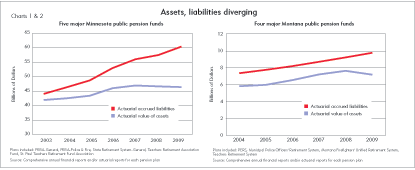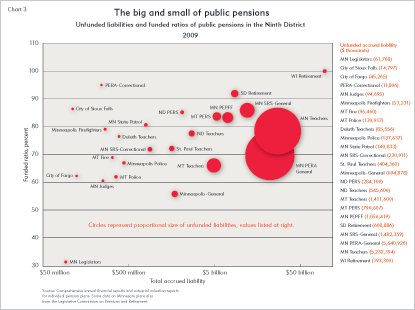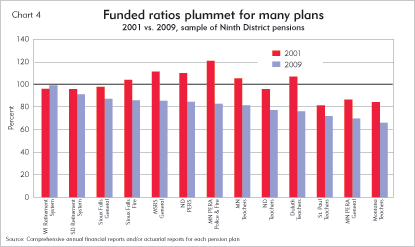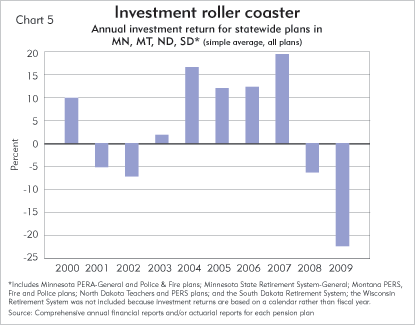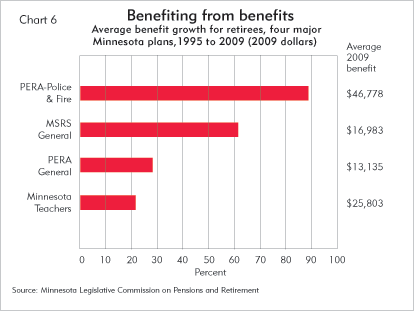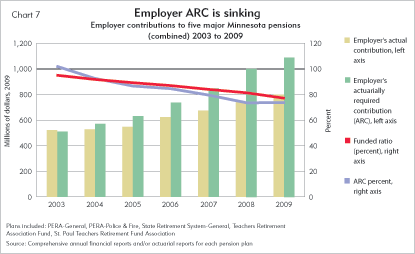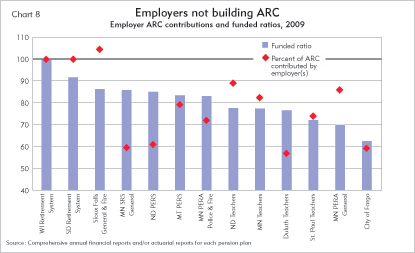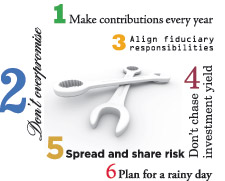
Most things in life have simple rules.
For example, doctors recommend a few things a person can do to live a healthy life: Eat your vegetables. Get eight hours of sleep. Drink plenty of water. Do 20 minutes of vigorous exercise at least three times a week.
There’s nothing particularly onerous about any of those, and yet people skip out on them with regularity, and doing so is easy to rationalize: Work has been a bear. My knees hurt. Don’t french fries and coffee count? Life is busy.
Simple rules also apply to the yawning concerns of public pensions. Though certainly less familiar (or memorable, for that matter), there are some basic rules that help keep public pension plans on the right path: Make the necessary contributions every year. Don’t promise benefits that you can’t guarantee with assets. Align fiduciary responsibilities with decision-making. Don’t chase investment yield. Spread and share risk. Plan for a rainy day.
And as with lifestyle rules, many local and state pension plans often aren’t following these rules—or aren’t allowed to—and so are paying the price. Almost all public pensions in the Ninth District are underfunded, some to the tune of hundreds of millions, even billions, of dollars—all of which is backed in full faith by taxpayers. The two dozen largest pensions in the district are underfunded by at least $20 billion, and the shortfall is likely to get worse before it gets better.
The most immediate source of the problem has been poor investment returns during the financial crisis, depleting pension assets rather than growing them. But the problem is both more subtle and more chronic than that. Public pensions exhibited signs of stress before the recession—outlined and highlighted in the May 2006 fedgazette—foreshadowing much of the current difficulty. Many plans haven’t been receiving the necessary payments. Past investment gains were shoveled into higher, guaranteed benefits. Plans failed to spread risk among stakeholders or provide escape hatches if—and now, when—funding ratios plummeted. But pensions are long term. They’ll bounce back. They always do.
The severity of the problem is hard to gauge exactly; we’re talking about predicting the future, and few plans are imminently insolvent. But many have crossed an unofficial line in the sand regarding their financial health. Much of the problem will ease if investment returns jump back quickly and robustly. But if they don’t, then problems will compound, and the fiscal tightrope already being walked by state and local governments will become more precarious. Pension defaults are virtually unheard of—so far—because the sponsoring governments themselves would have to declare bankruptcy before they skip out on legally guaranteed benefits. Instead, poorly funded plans get bailed out—stabilized with an infusion of tax dollars and sometimes subsumed by larger plans.
The good news is that lawmakers have taken unprecedented actions to fix problems. The bad news is that a costly pension system will get even more costly—and that’s if the fixes work. Most of the repairs to date involve significantly higher contributions from local and state governments (as well as employees) at a time when governments (and households) are under fiscal duress. Plans are only starting to address the fundamental fiduciary miscalculations that have put many of them in their current spot.
(Note: This article will focus only on retiree pensions. Unfunded obligations for retiree health care and other post-employment benefits are similarly significant and will be the focus of a separate future article in the fedgazette.)
Pension basics
Public pensions are familiar, yet obscure, to most people; they know what pensions are, but many don’t know what’s under the hood, so to speak.
Public pension plans come in many designs and colors. Some cover only certain types of workers—like teachers, corrections officers or firefighters. Some cities sponsor their own plans, but most choose to enroll their workers in state-sponsored plans. Still others, like the Wisconsin Retirement System, cover all government workers in the state, save for workers in the city and county of Milwaukee. The smallest plans have assets of a few million dollars; the largest, WRS, has assets and liabilities of almost $80 billion.
The financial mechanics of a pension plan are pretty straightforward. Every paycheck, the employee and the employer set money aside for the employee’s retirement. These regular contributions are invested so that they grow over time. When the worker decides to retire, this money funds a monthly check (called an annuity) that he or she receives until death. This simple system can work well, in theory and practice.
But underlying this simple, even elegant system is a connoisseur’s sausage-making machine, because each pension plan has innumerable moving parts that have to fit together to run smoothly and produce the desired result. Some are rules: how long you have to work before you can retire, how much each year of service earns you in retirement and how your final salary is calculated.
Other important parts are actuarial assumptions that help estimate future receipts and payments over time because pension managers have to know how much a worker’s retirement annuity will cost (referred to as liabilities). So plans identify a basket of variables that affect how much pension liabilities will grow, such as average work tenure and retirement age, likely pay increases, inflation rates, how long workers will live in retirement and myriad other considerations. Taking both rules and forecasts into consideration, plans can get a decent idea of how much money they will need in the future (usually 30 years out) to stay solvent.
In other words, pension plans have to painstakingly gaze into a crystal ball with multiple viewfinders. Plans chew through mountains of actuarial data—statistics of risk and probability—to guide their decision-making, but predicting the future isn’t easy. That’s why there is some wiggle room in a plan’s funded ratio—the percentage of actuarial (or projected) assets versus liabilities. It’s generally agreed that plans need not be 100 percent funded at all times; fluctuations occur for a variety of reasons, and corrections often follow. It’s more important over time that a plan’s assets slope at a trajectory similar to its liabilities so that it can afford to pay annuity checks in perpetuity.
And, in a nutshell, that’s the problem facing many pensions today. Pension liabilities have been rising steadily, while pension assets have mostly flattened or declined (see Charts 1 and 2). Across two dozen public pensions in the district, including the largest ones in each state, unfunded liabilities have reached about $20 billion (in fiscal year 2009, the most recent year available for comprehensive plan data). If not for methodological oddities (for example, Wisconsin uses a different, but valid, costing methodology than the one used by most plans), unfunded liabilities would be about $10 billion higher.
A funded ratio of at least 80 percent is a fairly crude, but widely accepted benchmark for pension health. Not including the WRS (it’s almost as large as all other pension plans put together, and technically fully funded), 23 pension plans across the district had a cumulative funded ratio of 78 percent as of fiscal year 2009 (see Chart 3).
Underfunded plans run the gamut from slightly malnourished to starving; the general plan for the Minnesota Public Employees Retirement Association— covering local government employees, with more than 200,000 active and retired members—is 70 percent funded; the plan for nonuniformed workers in Minneapolis stands at 56 percent (and is closed to new members). The statewide plan for Montana police is 62 percent funded; the pension for city employees in Fargo, N.D., is 57 percent funded. In maybe the most ironic case, the pension for Minnesota legislators is only 31 percent funded.
Since 2001, most large pension plans in the district have experienced a significant drop in their funded ratio of at least 10 percentage points and often much more (see Chart 4). Worse, unfunded liabilities are likely to grow in coming years, pushing funded ratios lower before any fixes can gain traction.
The heart attack
How pension funds got into this position is both simple (they got killed in the stock market) and complex (remember the sausage machine).
First, the easy and painful part. One of the most noteworthy actuarial assumptions in a pension plan is the return it expects to earn on invested assets (also called the discount rate because plans discount future liabilities as assets accrue). Most public pensions nationwide use a return benchmark of 8 percent, though they vary higher (Minnesota’s statewide plans use 8.5 percent) and lower (7.75 for the South Dakota Retirement System and several plans in Montana).
This assumption is noteworthy because the return on invested assets over 30 years tends to be very volatile, and small differences in the assumed return—say, between 7.5 percent and 8.5 percent—make a big difference in the calculation of unfunded liabilities. Many pension plans will be funded if they can achieve 8.5 percent returns, on average, for 30 years. But that’s a big and costly “if” because unfunded liabilities accrue if returns fall short, even if everything else in the sausage machine is running perfectly.
Pension advocates say the 8 percent benchmark is based on historical returns, but the fine print of any investor brochure points out that past returns are not a reliable indicator of future returns. From a short-term view, that might actually be good, because the past decade has been particularly poor (see Chart 5). Since 2001, there have been four negative return years, which are a double whammy for pensions. In 2002, for example, the largest district pensions lost an average of 7 percent, which means actuarial returns fell short of their benchmark by about 15 percentage points.
Although returns rebounded strongly in the middle of the decade, the historic collapse of 2008 and early 2009 was catastrophic to pension funds (see Chart 5, and Playing catch-up, badly). The large majority of plans saw a single-year loss approaching or exceeding 20 percent. The Minnesota State Retirement System’s (MSRS) plan for general employees has been one of the most stable and well-funded pension plans in the state. But its investments declined by 5 percent in 2008 before a haymaker 19 percent loss the following year.
Dave Bergstrom, MSRS executive director, said that in 2007, the plan’s actuary ran some models showing funding levels in different economic environments. “What happened in 2008 and 2009 was worse than even their worst economic projections. … No one anticipated such a quick and sharp drop.” Last year, the plan’s funded ratio hit 86 percent—not bad under the circumstances, but it stood at 110 percent less than a decade earlier.
Worse, funding levels are expected to decline across the board, possibly significantly. Investment losses don’t show up immediately in funded ratios because plans typically smooth returns over five years to remove volatility. That means that “there are significant investment losses yet to be recognized” as a result of asset smoothing, according to a February 2010 report on six major pension plans in Minnesota.
Though many plans have not released official returns or other financial information for fiscal year 2010, many have seen bounce-back returns of 10 percent to 20 percent. That will surely help, but preliminary information suggests that funded ratios will decline further. The Montana municipal police pension fund fell from 62 percent funded in 2009 to 57 percent this past fiscal year, with unfunded liabilities rising almost one-quarter to $163 million. An actuarial estimate last summer for the North Dakota Teachers Fund for Retirement showed that the fund’s ratio fell from 78 percent to 70 percent in fiscal year 2010.
The unhealthy diet
Within the sausage machine, many moving parts influence a funding ratio. It’s not hard, for example, for plans to tinker with various assumptions in ways that can hide financial problems.
One example is the amortization schedule—in essence, a future date at which the plan promises that assets will equal liabilities. The industry standard is 30 years—much like a home mortgage. A longer payment period allows for lower contributions and also makes a plan look better on paper. Among large district plans, one uses 50 years to amortize debt, and another does not amortize its debt on any time frame, which basically means it has no concrete plan to pay unfunded liabilities. Both are already significantly underfunded, but would look even worse if they followed industry accounting standards.
Poor actuarial standards are a difficult matter to corral because of their scope and complexity. While problematic, they are more likely to be symptomatic of broader, fiduciary practices at the root of current difficulties.
Two areas stand out: growth in (legally guaranteed) benefits and the failure of employers to make full pension contributions.
Most plans cannot increase member benefits on their own; they must be approved by their state or local sponsor. So benefit enhancements are most often the work of elected bodies. The 1990s, in particular, saw repeated benefit increases that were supported by employee unions and politically justified by high investment returns and mostly healthy government budgets.
Benefit growth among individual plans varies in breadth and depth. Among four major statewide plans in Minnesota, average benefits paid per service retiree outpaced inflation by at least 20 percent from 1995 to 2009. Some grew much more than that, though actual annuity levels per beneficiary vary significantly by plan (see Chart 6).
The increase in benefit levels comes from several sources. The most obvious is the increase in the so-called formula multiplier, which along with final salary and years of service, determines a retiree’s original monthly annuity.
Virtually all plans have regularly increased their multiplier. The South Dakota Retirement System—one of the most stable plans in the district—acknowledged in its latest financial report that its multiplier for general members has increased 11 times since 1982—from 1.1 percent to 1.7 percent—including five times between 1997 and 2002, and a final time in 2008. In 1982, the multiplier for North Dakota’s two statewide pension plans had a multiplier a shade over 1 percent. It currently stands at 2 percent. So a person today with a final salary of $40,000 at the end of a 25-year career would earn an annual pension of $20,000 (final salary × 2 percent × 25).
Whether that’s too generous is a subjective matter. The larger point is that the factors used to calculate a pension have been rising. With the direct link to wages, pensions automatically rise over time as wages go up, even if the multiplier remains the same. A rise in multiplier means pensions are increasing more than wage growth.
It should be noted that public workers contribute significantly to their pensions, while private workers with defined benefit pensions typically do not. But many public pensioners also receive annual (and compounding) cost of living adjustments in retirement—typically 1.5 percent to 3 percent—while private pensioners typically do not receive this benefit. That might seem like a small financial matter, but COLAs add up. An annually compounded COLA of just 1.5 percent over 15 years pushes a $20,000 pension up by 25 percent, to $25,000. Though some public plans make COLAs on an ad hoc basis, most plans do so automatically (via statute) and regardless of a plan’s financial condition.
Building an ARC
To make matters worse, governments have not been squirreling away the resources that actuaries say they should.
Every year, plans calculate the actuarially required contribution (ARC) that will help a plan maintain solvency over time. If a plan is underfunded, ARC standards call for additional, backfill payments to eventually bring assets back in line with liabilities. Think of a household with a lot of debt; ARC is like a prudent financial plan that establishes an ongoing payment schedule to steadily reduce debt over time. If a pension plan consistently meets its ARC, then its funding ratio should steadily improve, assuming the sausage machine cooperates.
Employers are not ignorant of such responsibilities, but pension costs have grown considerably, budgets have gotten tighter and other obligations compete for resources (see The pension bill. Ouch). Not making those extra payments for future unfunded liabilities can be easy to rationalize.
Among five major Minnesota plans, each has a unique ARC profile. But as a group, employer contributions as a percentage of ARC has trended down steadily since at least 2004 (see Chart 7), and funded status has followed in tow. That’s more rule than exception; a large majority of district pensions surveyed on this measure also failed to receive full actuarial contributions from employers in 2009 (see Chart 8). For many, this was a continuation of a trend stretching back to the middle of the decade, sometimes further.
The few plans that regularly make full ARC payments—the Wisconsin and South Dakota state retirement systems and separate plans with the city of Sioux Falls, S.D.—are legally bound to do so. Coincidentally, they are also the best-funded plans in the district.
Most plans, however, are not similarly bound. Indeed, “required” contribution is mostly a misnomer—“prudent” would be more accurate. Employers and workers are compelled to make “normal cost” contributions—the projected cost of benefits for working members, as if the plan were 100 percent funded. Usually this contribution rate for both employers and employees is set in statute as a percentage of payroll.
A decade ago, this wasn’t a problem because many plans were near (or over) 100 percent funded. With fixed contribution rates, many were actually contributing more than actuarially required. In 2000, Minnesota’s major pension plans paid roughly 30 percent more than their ARC said was necessary, according to the state’s Legislative Commission on Pensions and Retirement.
But when plans have unfunded liabilities—particularly below 80 percent—actuaries urge additional contributions to help close that gap. But few plans are legally bound to make these additional payments, and most do not have the authority to force employers and workers to contribute more than the amount set in statute.
For an underfunded plan, failing to pay ARC is like applying more grease to the hill. The 2010 report on six major pension plans in Minnesota found that many make only statutory contributions, and “very little … can be used to pay down—or even pay the interest on—the outstanding unfunded actuarial liability amounts.”
Patient, heal thyself?
From a broad perspective, the sky might be said to have some large cracks, but is not in immediate danger of falling. Most plans have the resources to pay benefits in the near term, and usually there is time to turn around a struggling fund.
But not always. Sometimes matters are left unaddressed for too long, and plans become a death spiral as a growing number of retirees consume a plan’s assets faster than they can be replenished by contributions and investment returns. While bankruptcy is being mentioned more often—particularly in places like California and Illinois, where plans are in worse shape—it’s still an extreme rarity among plans, at least so far, because it would require the sponsoring government to declare bankruptcy, which has serious financial and political considerations.
Instead, plans seek something akin to a bailout. For example, the city of Minneapolis’ general employee plan could default on benefits within the decade. Last year, the plan was merged with the statewide PERA-General plan, which is good for retired members (whose benefit guarantees are financially reinforced) but considerably less good for other parties; city taxpayers face annual costs of $27 million to $35 million—for a closed plan with fewer than 200 active members and about 4,500 retirees—and the state will pitch in another $27 million in 2012 and 2013, and then $15 million every year thereafter. A few years earlier, a similar bailout occurred with the Minneapolis teachers’ pension.
Without significant changes, other underfunded plans also face a sketchy future. The North Dakota Teachers Fund for Retirement was on track to go “bone dry” in about 20 years “unless we did something,” according to Greg Burns, executive director of the North Dakota Teachers Association. With the fund hovering around 80 percent in 2008, employer contributions were raised by 1 percentage point, phased in over three years. But more dramatic action was needed this time around after steep investment losses. Stakeholder groups were called in, said Burns, “and we spent hours upon hours looking at the pension plan to fix this thing.”
The group ended up proposing—and the Legislature will consider this spring—contribution increases of four percentage points for both employers and workers, phased in over four years, eventually pushing rates for both to between 12 percent and 13 percent of payroll. These rates are scheduled to sunset only when the plan is once again at least 90 percent funded, which is not expected until 2032, according to Burns. The plan also set higher age requirements for earning full benefits.
“Not one member has complained,” said Burns, although he acknowledged “that might change” once the higher rates go into effect.
Elected bodies elsewhere are investigating their options. In Montana, pensions for teachers (TRS plan) and local and state workers (PERS) were estimated last summer to be underfunded by about $2 billion, a level that “may not amortize in any length of time without increased contributions and benefit changes or plan design changes,” according to a legislative report. A special legislative committee was charged with brainstorming some solutions. It suggested two basic options, but only for new employees: going to a defined contribution plan or modifying current retirement rules with longer vesting and service requirements and lower multipliers. The matter awaits the 2011 Legislature.
Significant changes have been made to virtually all of Minnesota’s larger plans. Last year, the Legislature passed a pension bill that increased contributions for both employers and employees for the larger statewide plans, some by as much as 2 to 3 percentage points, usually phased in over two to four years. There were also a number of benefit reductions, including for retirees, but these changes face a legal challenge (more on this below).
Fix, don’t patch
That such drastic measures are necessary suggests that plans are missing some mechanisms that might offer better, more automatic safeguards. When plans are underfunded, corrective measures have to go through a time-consuming legislative process—which might produce a decent patch job, but often fails to address some of the underlying problems or offer mechanisms that might automatically stabilize underfunded plans before they get into serious difficulty.
There have been some recent, notable achievements on this front. North Dakota’s two statewide plans now automatically raise or lower employer and worker contributions slightly in relation to a 90 percent benchmark—a novelty among many plans. All three of Minnesota’s statewide funds have been given the authority to raise and lower contribution rates, rather than wait for legislative approval. Additional rules allow plans to keep a 1 percent contribution “cushion” to help weather market corrections, and restrict the use of surplus funds for new or additional benefits.
These governance changes are “very significant,” according to Mary Most Vanek, head of the Minnesota PERA plan. The legislative practice of delaying contribution increases with the hopes of reaping higher investment returns in the future “was not prudent management,” she said, because it abdicated a plan’s fiduciary responsibility to members, employers and taxpayers. But the authority given to plans is still new, and it’s unclear whether and how that power will be exercised. The recent large increases in contribution rates were the result of legislative action.
Another safeguard that is almost universally absent is the sharing of investment risk among pension stakeholders. Over the past several decades, plans have gradually taken on more risk with investment portfolios, shifting assets out of cash and bonds and into equities in hopes of achieving higher returns. Until recently, the strategy had worked well, fueling much larger growth in plan assets than otherwise would have been achieved.
But the rarity of plan bankruptcy, along with the prevalence of bailouts, has invited moral hazard because risk has been misappropriated. Plan beneficiaries bear little risk but have enjoyed most of the benefits. Though governments have taken some funding holidays because of strong investment returns, more often those heady returns provided rationale for higher, compounding benefits. When returns stumble, employers (and by extension, taxpayers) have shouldered a disproportionate share of the financial risk. Active workers also have carried some risk, usually in the form of higher contributions. But the largest benefactors—retirees, and those close to retirement—are largely absolved of any real risk; they no longer make contributions (or soon won’t), and benefits—both earned and promised—have strong legal protections.
Not everyone believes the prevailing risk-sharing arrangement is out of whack. Michael Nelson is a customer service specialist with the Minnesota Office of the Secretary of State and head of the 800-member Local 2829 union representing state employees. “I think the current risk structure is equitable, if the employer makes wise decisions when planning for future retiree costs rather than neglecting their liabilities until the plans reach crisis,” Nelson said.
Some workers’ unions are also taking the matter to court to repeal recent attempts to lower benefit levels. In South Dakota, a class-action lawsuit is challenging the state’s cut of annual post-retirement increases from an automatic 3.1 percent to between 2.1 percent and 2.8 percent when the plan is below 100 percent.
Minnesota also faces a legal challenge to its recent lowering of post-retirement increases. The changes vary among the different statewide plans, but include a temporary two-year suspension of cost-of-living adjustments and lower future increases until a 90 percent funding threshold is attained. Bergstrom, from the State Retirement System, said it was too early to speculate, but acknowledged that “if the lawsuit is successful, it will obviously have a financial impact on our plan. Our savings will not be as great, and other changes may be necessary.”
Keith Bozarth, executive director of the State of Wisconsin Investment Board, said court battles are necessary to provide some clarity to an important, but cloudy legal matter. “I don’t think benefits are as ironclad as many believe,” said Bozarth, adding that “litigation will be a healthy thing because it will give us a framework” to work from in the future. (For more discussion, see Public pension benefits & the law for a Q&A with two legal experts from Minnesota regarding the legal protections and case law concerning pension benefits.)
Good and bad déjà vu
It’s easy to buy into a worst-case, into-the-abyss scenario, until you step back and realize that many funds were in similar or worse shape in the 1970s and 1980s. Badly underfunded, plans shifted their focus to an investment growth strategy, and many literally grew their way out of trouble in the robust money markets of the late 1980s and 1990s.
But that strategy also has played a large role in the current predicament. With an uncertain and possibly volatile future for investment returns, the key for many plans will be to make changes that help reduce their unfunded liabilities over time while allowing them greater flexibility to adapt and reinforce their fiduciary responsibilities to both members and taxpayers. In this vein, plans in Wisconsin and Sioux Falls offer useful models (see Top of the pension class).
Bozarth said there are many good pension plans out there, “but there are many examples of funding discipline that is not in place.” That has many critics wanting to throw out defined benefit pensions altogether. Bozarth believes that is unnecessary, even rash: “The solution is responsible plan design.”
Dave Stella, secretary of the Wisconsin Department of Employee Trust Funds, which administers WRS, said too much attention has been paid to poor investment returns. “We’ve got a slow-motion train wreck, and a lot of attention is being placed on a small part of the train,” he said. Instead, he suggested that plans need to focus on governance, shared risk and appropriate benefit levels. “You can’t promise benefits you can’t pay for.”
He also believes that many plans are now feeling the pressure necessary to make tough choices. “Crisis generates reaction, and [decision makers] won’t watch the boat go over the waterfall,” he said.
Ron Wirtz is a Minneapolis Fed regional outreach director. Ron tracks current business conditions, with a focus on employment and wages, construction, real estate, consumer spending, and tourism. In this role, he networks with businesses in the Bank’s six-state region and gives frequent speeches on economic conditions. Follow him on Twitter @RonWirtz.



